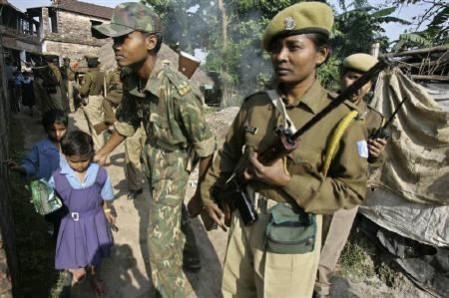
A decade is a long time in politics. And on Tuesday, March 14, 2017, West Bengal Chief Minister and Trinamool Congress supremo Mamata Banerjee will concede that.
It was on this day 10 years ago that 14 people were killed after the police started firing in reaction to the growing violence in Nandigram in East Midnapore district of the state over the setting up of a special economic zone by Indonesia's Salim Group. The then Left Front government had completely failed to manage the situation on the ground and Buddhadeb Bhattacharya, who was the chief minister then, had helplessly witnessed the beginning of the fall of a three-decade-old regime in the wake of the killings.
The massive anti-incumbency wave which was generated as a result of the violence and the police action in Nandigram, accompanied by the Nano factory fiasco in Singur, saw the opposition Trinamool Congress (TMC) making serious gains in its fight with the arch-enemies for the first time. In 2011, just over four years after the incident, the Left was ousted from power and Banerjee emerged as the new face of Bengal. Before that, in 2008, the Left was decimated in the panchayat elections in the district.
Nandigram & Singur gave Mamata's political career a boost
Nandigram and Singur have remained oft-cited political terms since then. The state has not seen any industrial progress and Banerjee and her party remained the only beneficiaries of those episodes. Last year, the history was rewound in Singur after the Supreme Court gave its verdict against the Left's initiative there and the Banerjee government flagged off the process to return the land to the farmers. She had also made use of the Nandigram sentiment to make abundant populist promises to the local people and everything culminated into her emerging as the tallest political figure in Bengal.

Banerjee worked hard since 2007 to inch towards a national role
But 10 years since the Left's decline started and Mamata Banerjee's rise began, circumstances have changed immensely. The TMC chief has worked hard all these years towards not only grabbing power in the state but also gradually progressing towards the national scenario. Last year, when she said in Singur that the "Singur model" would be imitated across the world, the tinge of her aspiration to become famous by claiming to engineer a new economic theory of sort became clearer.
She then took up the issue of demonetisation to make her voice heard in the power corridors of New Delhi. After having comprehensively trounced the opposition twice in Bengal, Banerjee moved towards Delhi and she did not waste any time to target Prime Minister Narendra Modi on the issue of demonetisation. She even embarked on national tours to prove a point, hoping that the 2019 elections would see her getting enough pan-Indian support to challenge the Modi phenomenon. She approached other regional satraps to get the act together and put up a force for the next big battle.
But on March 14, 2017, Mamata finds the going getting tougher
The results in Assembly elections in five states, announced just three days ahead of Nandigram's 10th anniversary, must have left the firebrand leader dejected. She posted a tweet, which was crafted diplomatically after the BJP decimated all its opponents but inside stories say that the TMC supremo is extremely upset, and could see her all-India ambitions getting crippled in the days to come. Even her party's lone elected MLA in Manipur joined the BJP, the party she and her party have been resisting throughout.
Banerjee might have never thought that a politician named Narendra Modi, who is much junior to her in national politics, would seriously hurt her prospects of emerging as a frontrunner to Delhi's throne. The frustration has been visible in her speeches and acts but people's hearts cannot be won by abusing opponents alone.
Modi is a much smarter opponent as compared to the Left in its last days and the familiar formula of making use of popular sentiments against the establishment to turn the tables around is almost non-effective against the BJP strongman at the moment.
March 14, 2007, had given an unprecedented break to Banerjee's political career. On March 14, 2017, she is perhaps seeing the writing on the wall.

















